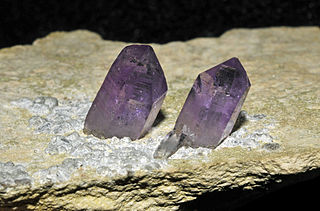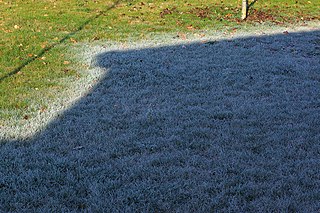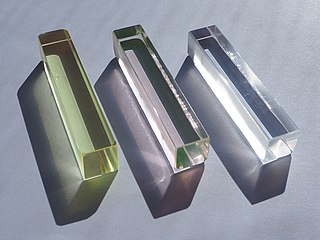Related Research Articles

A crystal or crystalline solid is a solid material whose constituents are arranged in a highly ordered microscopic structure, forming a crystal lattice that extends in all directions. In addition, macroscopic single crystals are usually identifiable by their geometrical shape, consisting of flat faces with specific, characteristic orientations. The scientific study of crystals and crystal formation is known as crystallography. The process of crystal formation via mechanisms of crystal growth is called crystallization or solidification.

A ceramic is any of the various hard, brittle, heat-resistant and corrosion-resistant materials made by shaping and then firing an inorganic, nonmetallic material, such as clay, at a high temperature. Common examples are earthenware, porcelain, and brick.

Frost is a thin layer of ice on a solid surface, which forms from water vapor in an above-freezing atmosphere coming in contact with a solid surface whose temperature is below freezing, and resulting in a phase change from water vapor to ice as the water vapor reaches the freezing point. In temperate climates, it most commonly appears on surfaces near the ground as fragile white crystals; in cold climates, it occurs in a greater variety of forms. The propagation of crystal formation occurs by the process of nucleation.

Glass is a non-crystalline, often transparent, amorphous solid that has widespread practical, technological, and decorative use in, for example, window panes, tableware, and optics. Glass is most often formed by rapid cooling (quenching) of the molten form; some glasses such as volcanic glass are naturally occurring. The most familiar, and historically the oldest, types of manufactured glass are "silicate glasses" based on the chemical compound silica, the primary constituent of sand. Soda–lime glass, containing around 70% silica, accounts for around 90% of manufactured glass. The term glass, in popular usage, is often used to refer only to this type of material, although silica-free glasses often have desirable properties for applications in modern communications technology. Some objects, such as drinking glasses and eyeglasses, are so commonly made of silicate-based glass that they are simply called by the name of the material.

A polymer is a substance or material consisting of very large molecules called macromolecules, composed of many repeating subunits. Due to their broad spectrum of properties, both synthetic and natural polymers play essential and ubiquitous roles in everyday life. Polymers range from familiar synthetic plastics such as polystyrene to natural biopolymers such as DNA and proteins that are fundamental to biological structure and function. Polymers, both natural and synthetic, are created via polymerization of many small molecules, known as monomers. Their consequently large molecular mass, relative to small molecule compounds, produces unique physical properties including toughness, high elasticity, viscoelasticity, and a tendency to form amorphous and semicrystalline structures rather than crystals.

Freezing is a phase transition where a liquid turns into a solid when its temperature is lowered below its freezing point. In accordance with the internationally established definition, freezing means the solidification phase change of a liquid or the liquid content of a substance, usually due to cooling.
Glass-ceramics are polycrystalline materials produced through controlled crystallization of base glass, producing a fine uniform dispersion of crystals throughout the bulk material. Crystallization is accomplished by subjecting suitable glasses to a carefully regulated heat treatment schedule, resulting in the nucleation and growth of crystal phases. In many cases, the crystallization process can proceed to near completion, but in a small proportion of processes, the residual glass phase often remains. Glass-ceramic materials share many properties with both glasses and ceramics. Glass-ceramics have an amorphous phase and one or more crystalline phases and are produced by a so-called "controlled crystallization" in contrast to a spontaneous crystallization, which is usually not wanted in glass manufacturing. Glass-ceramics have the fabrication advantage of glass, as well as special properties of ceramics. When used for sealing, some glass-ceramics do not require brazing but can withstand brazing temperatures up to 700 °C. Glass-ceramics usually have between 30% [m/m] and 90% [m/m] crystallinity and yield an array of materials with interesting properties like zero porosity, high strength, toughness, translucency or opacity, pigmentation, opalescence, low or even negative thermal expansion, high temperature stability, fluorescence, machinability, ferromagnetism, resorbability or high chemical durability, biocompatibility, bioactivity, ion conductivity, superconductivity, isolation capabilities, low dielectric constant and loss, corrosion resistance, high resistivity and break-down voltage. These properties can be tailored by controlling the base-glass composition and by controlled heat treatment/crystallization of base glass. In manufacturing, glass-ceramics are valued for having the strength of ceramic but the hermetic sealing properties of glass.

Supercooling, also known as undercooling, is the process of lowering the temperature of a liquid below its freezing point without it becoming a solid. It achieves this in the absence of a seed crystal or nucleus around which a crystal structure can form. The supercooling of water can be achieved without any special techniques other than chemical demineralization, down to −48.3 °C (−54.9 °F). Droplets of supercooled water often exist in stratus and cumulus clouds. An aircraft flying through such a cloud sees an abrupt crystallization of these droplets, which can result in the formation of ice on the aircraft's wings or blockage of its instruments and probes.

In petrology, spherulites are small, rounded bodies that commonly occur in vitreous igneous rocks. They are often visible in specimens of obsidian, pitchstone, and rhyolite as globules about the size of millet seed or rice grain, with a duller luster than the surrounding glassy base of the rock, and when they are examined with a lens they prove to have a radiate fibrous structure.
In physics and chemistry, flash freezing is the process whereby objects are frozen in just a few hours by subjecting them to cryogenic temperatures, or through direct contact with liquid nitrogen at −196 °C (−320.8 °F). It is commonly used in the food industry.

Dental porcelain is a dental material used by dental technicians to create biocompatible lifelike dental restorations, such as crowns, bridges, and veneers. Evidence suggests they are an effective material as they are biocompatible, aesthetic, insoluble and have a hardness of 7 on the Mohs scale. For certain dental prostheses, such as three-unit molars porcelain fused to metal or in complete porcelain group, zirconia-based restorations are recommended.

Tachylite is a form of basaltic volcanic glass. This glass is formed naturally by the rapid cooling of molten basalt. It is a type of mafic igneous rock that is decomposable by acids and readily fusible. The color is a black or dark-brown, and it has a greasy-looking, resinous luster. It is very brittle and occurs in dikes, veins, and intrusive masses. The word originates from the Ancient Greek ταχύς, meaning "swift".

Crystallization is the process by which solid forms, where the atoms or molecules are highly organized into a structure known as a crystal. Some ways by which crystals form are precipitating from a solution, freezing, or more rarely deposition directly from a gas. Attributes of the resulting crystal depend largely on factors such as temperature, air pressure, and in the case of liquid crystals, time of fluid evaporation.

ZBLAN is the most stable, and consequently the most used, fluoride glass, a subcategory of the heavy metal fluoride glass (HMFG) group. Typically its composition is 53% ZrF4, 20% BaF2, 4% LaF3, 3% AlF3 and 20% NaF. ZBLAN is not a single material but rather has a spectrum of compositions, many of which are still untried. The biggest library in the world of ZBLAN glass compositions is currently owned by Le Verre Fluore, the oldest company working on HMFG technology. Other current ZBLAN fiber manufacturers are Thorlabs and KDD Fiberlabs. Hafnium fluoride is chemically similar to zirconium fluoride, and is sometimes used in place of it.
Amorphous ice is an amorphous solid form of water. Common ice is a crystalline material wherein the molecules are regularly arranged in a hexagonal lattice, whereas amorphous ice has a lack of long-range order in its molecular arrangement. Amorphous ice is produced either by rapid cooling of liquid water, or by compressing ordinary ice at low temperatures.
In geology, texture or rock microstructure refers to the relationship between the materials of which a rock is composed. The broadest textural classes are crystalline, fragmental, aphanitic, and glassy. The geometric aspects and relations amongst the component particles or crystals are referred to as the crystallographic texture or preferred orientation. Textures can be quantified in many ways. The most common parameter is the crystal size distribution. This creates the physical appearance or character of a rock, such as grain size, shape, arrangement, and other properties, at both the visible and microscopic scale.

Solid is one of the four fundamental states of matter. The molecules in a solid are closely packed together and contain the least amount of kinetic energy. A solid is characterized by structural rigidity and resistance to a force applied to the surface. Unlike a liquid, a solid object does not flow to take on the shape of its container, nor does it expand to fill the entire available volume like a gas. The atoms in a solid are bound to each other, either in a regular geometric lattice, or irregularly. Solids cannot be compressed with little pressure whereas gases can be compressed with little pressure because the molecules in a gas are loosely packed.
Crystallization of polymers is a process associated with partial alignment of their molecular chains. These chains fold together and form ordered regions called lamellae, which compose larger spheroidal structures named spherulites. Polymers can crystallize upon cooling from melting, mechanical stretching or solvent evaporation. Crystallization affects optical, mechanical, thermal and chemical properties of the polymer. The degree of crystallinity is estimated by different analytical methods and it typically ranges between 10 and 80%, with crystallized polymers often called "semi-crystalline". The properties of semi-crystalline polymers are determined not only by the degree of crystallinity, but also by the size and orientation of the molecular chains.
Gallium lanthanum sulfide glass is the name of a family of chalcogenide glasses, referred to as gallium lanthanum sulfide (Ga-La-S) glasses. They are mixtures of La2S3, La2O3, and Ga2S3, which form the basic glass with other glass modifiers added as needed. Gallium-lanthanum-sulfide glasses have a wide range of vitreous formation centered around a 70% Ga2S3 : 30% La2S3 mixture, and readily accept other modifier materials into their structure. This means that Ga-La-S composition can be adjusted to give a wide variety of optical and physical properties.
Hoffman nucleation theory is a theory developed by John D. Hoffman and coworkers in the 1970s and 80s that attempts to describe the crystallization of a polymer in terms of the kinetics and thermodynamics of polymer surface nucleation. The theory introduces a model where a surface of completely crystalline polymer is created and introduces surface energy parameters to describe the process. Hoffman nucleation theory is more of a starting point for polymer crystallization theory and is better known for its fundamental roles in the Hoffman–Weeks lamellar thickening and Lauritzen–Hoffman growth theory.
References
- ↑ Werner Vogel: "Glass Chemistry"; Springer-Verlag Berlin and Heidelberg GmbH & Co. K; 2nd revised edition (November 1994), ISBN 3-540-57572-3
- ↑ Gualtieri, A.F.; Foresti, E.; Lesci, I.G.; Roveri, N.; Gualtieri, M. Lassinantti; Dondi, M.; Zapparoli, M. (March 2009). "The thermal transformation of Man Made Vitreous Fibers (MMVF) and safe recycling as secondary raw materials (SRM)". Journal of Hazardous Materials. 162 (2–3): 1494–1506. doi:10.1016/j.jhazmat.2008.06.066.
- ↑ Comodi, Paola; Cera, Fabio; Diego Gatta, Jacomo; Rotiroti, Nicola; Garofani, Patrizia (20 August 2010). "The Devitrification of Artificial Fibers: A Multimethodic Approach to Quantify the Temperature–Time Onset of Cancerogenic Crystalline Phases". The Annals of Occupational Hygiene. 54 (8): 893–903. doi: 10.1093/annhyg/meq056 .